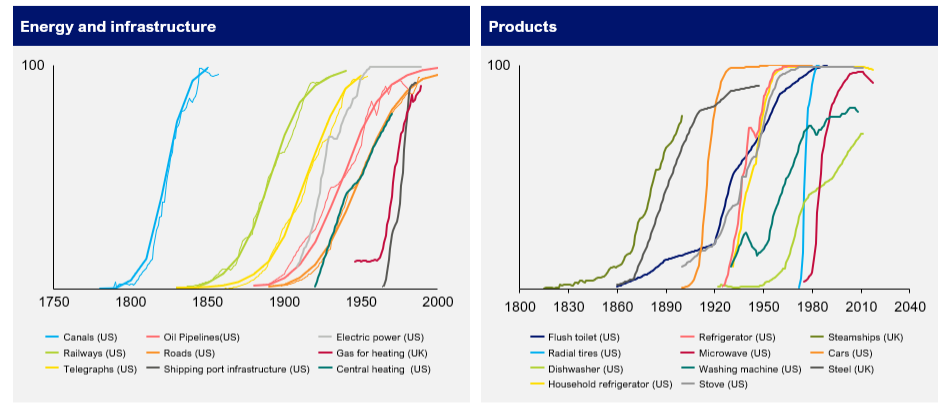Opinion from Maaike Witteveen, Director Energy Platform at Systemiq.
We don’t seem to have any problem with thinking about AI scaling exponentially. We should apply the same bold vision to climate technology.
Especially since OpenAI’s launch of ChatGPT and more recently DeepSeek, the impact of AI on our global economy is increasingly predicted to be revolutionary, reshaping our jobs and homes while potentially enhancing sectors from healthcare to education. Even though there is more excitement than productivity impact just yet, regulation and policy frameworks are being adjusted to ensure that these new technologies can reach their full potential fast and responsibly.
It seems that, in many instances, no such exponential thinking is happening for climate technology, despite evidence to the reverse. Many mainstream forecasters predicted steady, linear growth for solar PV panels, wind turbines and electric vehicles in the last decades, even though the technologies have showed exponential growth in deployment in most of these years. Solar PV and onshore wind have been growing exponentially at yearly growth rates of 29% and 15% respectively in the last 15 years until 2023.
There is no reason why we should think only linearly about climate technology deployment. Exponential thinking is well-understood for technologies, like AI, that are guided by Moore’s law. However, history suggests that the uptake of many, very different technologies follow an S-curve logic. This can range from cars and electric power in the US to shipping and gas for heating in the UK, see the graph below. Growth starts slow, until the technology rapidly gains speed (the exponential growth towards the steep part of the S-curve), before it slows down again just before maximum adoption level is reached, transforming a sector sometimes within a decade or two.

Historical adoption of new technologies. Source: The Breakthrough Effect, Systemiq 2023
This exponential growth of new technologies was highlighted in The Breakthrough Effect report which shows how parts of the global economy could move rapidly towards zero emissions. According to the report, a tipping point is reached when the new solution is more affordable, attractive and accessible than the conventional solution. That means that self-sustained exponential growth of climate solutions will require more than ‘just’ climate impact, but also benefits on other dimensions that can include costs, (public) health, energy independence, economic resilience etc. For some technologies such ‘win-win-wins’ are already apparent: battery-electric cars that lead to less pollution and noise in cities, and solar panels, wind turbines and batteries bring fast to build and resilient energy generation for critical infrastructure in Ukraine.
Not all climate technologies have reached a global tipping point to exponential growth yet, although some seem to be closing in, for example electrothermal energy storage and electric trucking. Others are further away, such as zero-carbon plastics or electricity-based sustainable aviation fuel, although the differences between geographies are extensive. The uptake of a technology does not only require manufacturing or build out at scale, but also other system’s conditions to be in place to support growth. Depending on the technologies, progress in policy and regulation, workforce capability, technology maturity and cost, infrastructure, supply chains, public awareness or other parts of the system is needed before they can begin to accelerate. Understanding precisely what barriers should be overcome and which actions are needed for that can help reaching a tipping point in these technologies.

Maaike Witteveen, Director Energy Platform at Systemiq
But, just like with AI, it will not always be a smooth growth curve and with progress comes challenges. For example, inflation and higher interest rates are slowing down growth in offshore wind that was on an exponential growth trajectory for almost two decades. And impact of the new US presidency on all technologies – not only climate – is hard to predict. On top of that, the challenges that come with growth are non-trivial. For example, the resources needed to manufacture these technologies, like critical minerals or bioresources, should be carefully managed and made circular to limit or reverse environmental pressures and impacts. Also, there will be conscious trade-offs needed in areas such as strategic autonomy, local industry competitiveness and space planning.
That does not mean that we should stick with thinking linearly. Countries and businesses that think linearly can find themselves unprepared for what can seem like a sudden uptake of new technologies. Risks can include a sudden decrease in relevance of a product or economic sector, infrastructure that cannot cope, and missed opportunities to capture benefits that an exponentially growing technology can provide. For example, Asian manufacturers are dominating the – exponentially growing global battery market, with other regions trying to catch up.
So, what should governments and businesses do? Governments and businesses should start thinking in exponential, instead of only linear, trajectories for climate technology deployment. They should explore which climate solutions can have an outsized impact on their geography or sector. They should understand what system’s conditions should be in place to reach a tipping point and enable exponential growth. They should be ready to adapt their policies and strategies to accelerate climate solution tipping points responsibly and to capture the opportunities that these will bring.




